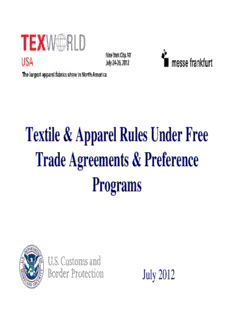
Textile & Apparel Rules Under Free Trade Agreements & Preference PDF
Preview Textile & Apparel Rules Under Free Trade Agreements & Preference
Textile & Apparel Rules Under Free Trade Agreements & Preference Programs July 2012 2 3 U.S. Customs and Border Protection Priority Trade Issues (PTIs) Agriculture Programs Antidumping and Countervailing Duties (ADCVD) Intellectual Property Rights Textiles The goal of the Textiles PTI is to ensure that textile Import Safety imports, which generate more than 40% of the duties collected by CBP, fully comply with applicable laws, regulations, quotas, Free Penalties Trade Agreement requirements, and Intellectual Property provisions. Revenue Trade Agreements The objective of the Trade Agreements PTI is to advance CBP’s mission by working with internal and external stakeholders to facilitate legitimate trade and address areas of Textiles non-compliance while effectively communicating the terms of our free trade agreements and preferential trade legislation. The TA PTI is limited to goods other than textiles and apparel, as textiles Trade Agreements and apparel products are handled under a separate Textiles PTI. 4 CBP Textiles Priority Trade Issue U.S. Imports of Textile and Apparel Goods Total $115 Billion Account for Approximately 43% of All Duties Collected Key Industry for the U.S. Economy Highly Regulated and Legislated FTAs (17% of Textile and Apparel Imports Claim a Preference) Key Industry for Free Trade Agreements Key Industry for Administration’s Trade Policy Key Industry for Congressional Legislation 55 Textile/Apparel Supplier Countries by Value FY10 FY11 1 China 42% 1 China 41% 2 Vietnam 6% 2 Vietnam 6% 3 Mexico 6% 3 India 6% 4 India 5% 4 Mexico 5% 5 Indonesia 4% 5 Indonesia 5% 6 Bangladesh 4% 6 Bangladesh 4% 7 Pakistan 3% 7 Pakistan 3% 8 Honduras 2% 8 Honduras 2% 9 Canada 2% 9 Cambodia 2% 10 Cambodia 2% 10 Canada 2% 11 Italy 2% 11 Italy 2% 12 Thailand 2% 12 El Salvador 2% 13 El Salvador 2% 13 Thailand 1% 14 Sri Lanka 1% 14 Sri Lanka 1% 15 Guatemala 1% 15 Guatemala 1% 66 CBP Textiles Priority Trade Issue Enforcement Efforts Unilateral/Bilateral/Multilateral Preference Programs African Growth and Opportunity Act (AGOA) Qualifying Industrial Zones; Jordan/Israel/Egypt Caribbean Basin Trade Partnership Act, Haiti HOPE and HELP Andean Trade Promotion and Drug Eradication Act Free Trade Agreements (Australia, Bahrain, CAFTA, Colombia, Chile, Israel, Jordan, Korea, Morocco, NAFTA, Oman, Peru, Singapore) Trade Agreements Have Become a Critical Element in the Overall Foreign Policy of the United States Unique Qualifying Rules for Each for Textile and Apparel Goods 170 Textile & Apparel Rules Under Free Trade Agreements & Preference Programs U.S. Legal Concepts of “Shared Responsibility,” “Informed Compliance,” and “Reasonable Care” Apply to Importers By Making a Claim for Preferential Treatment Under a FTA or Preference Program, the Importer of Record is Declaring to CBP They KNOW, UNDERSTAND and MEET the Preference Rule No Special Documents are Needed for Entry Purposes If Asked, the Importer of Record Must Substantiate the Claim is Valid 8 Textile & Apparel Rules Under Free Trade Agreements & Preference Programs CBP and Other U.S. Government Public Resources: Where to find information, instructions and guidance about Free Trade Agreements and preference programs. FTA & Preference Rules: Basic summary of the types preference rules for preferential treatment, how to file a claim for preferential treatment. CBP Verification Procedures: Review of U.S. Customs and Border Protection procedures for implementing and enforcing the terms of the agreement or program. 9 CBP and Other U.S. Government Public Resources Where to find information, instructions and guidance about Free Trade Agreements and preference programs. 10
Description: